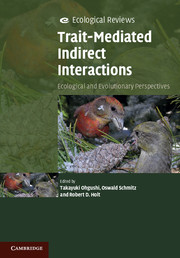Book contents
- Frontmatter
- Contents
- Contributors
- Foreword
- Preface
- Chapter One Introduction
- Part I Community
- Part II Coevolution
- Part III Ecosystem
- Chapter Sixteen Perspective
- Chapter Seventeen Species functional traits, trophic control and the ecosystem consequences of adaptive foraging in the middle of food chains
- Chapter Eighteen Effects of herbivores on terrestrial ecosystem processes
- Chapter Nineteen Functional and heritable consequences of plant genotype on community composition and ecosystem processes
- Chapter Twenty Microbial mutualists and biodiversity in ecosystems
- Chapter Twenty-One Integrating trait-mediated effects and non-trophic interactions in the study of biodiversity and ecosystem functioning
- Part IV Applied Ecology
- Index
- Plate Section
- References
Chapter Sixteen - Perspective
interspecific indirect genetic effects (IIGEs). Linking genetics and genomics to community ecology and ecosystem processes
Published online by Cambridge University Press: 05 February 2013
- Frontmatter
- Contents
- Contributors
- Foreword
- Preface
- Chapter One Introduction
- Part I Community
- Part II Coevolution
- Part III Ecosystem
- Chapter Sixteen Perspective
- Chapter Seventeen Species functional traits, trophic control and the ecosystem consequences of adaptive foraging in the middle of food chains
- Chapter Eighteen Effects of herbivores on terrestrial ecosystem processes
- Chapter Nineteen Functional and heritable consequences of plant genotype on community composition and ecosystem processes
- Chapter Twenty Microbial mutualists and biodiversity in ecosystems
- Chapter Twenty-One Integrating trait-mediated effects and non-trophic interactions in the study of biodiversity and ecosystem functioning
- Part IV Applied Ecology
- Index
- Plate Section
- References
Summary
Introduction
Trait-mediated indirect interactions (TMIIs) are important mediators of community diversity and structure and associated ecosystem processes. Elucidating the genetic basis of ecologically important phenotypic traits is the first step toward understanding the complex interactions that occur among community members. Molecular markers routinely used in quantitative trait loci (QTL) analyses (e.g., amplified fragment length polymorphisms (AFLPs), simple sequence repeats (SSRs)) have provided researchers with a toolbox for investigating the genetic basis of heritable traits. A goal of this research is to link genetically based traits to community interactions and ecosystem function. Ultimately, this insight can open a window onto the evolutionary dynamics that shape community structure and associated ecosystem processes (e.g., nutrient cycling). Such an approach is important as it bears on the continued development of the field of community genetics, which seeks to understand the genetic interactions that occur between species and their abiotic environment in complex communities (e.g., Whitham et al. 2003, 2006; Johnson and Agrawal 2005; LeRoy et al. 2006; Bangert et al. 2006a, b; Schweitzer et al. 2008; Crutsinger et al. 2009; Bailey et al. 2009).
- Type
- Chapter
- Information
- Trait-Mediated Indirect InteractionsEcological and Evolutionary Perspectives, pp. 295 - 323Publisher: Cambridge University PressPrint publication year: 2012
References
- 13
- Cited by

